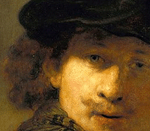
"Christ Before the High Priest"
Duccio was an Italian painter active in Siena, Tuscany, in the late 13th and early 14th century. He was hired throughout his life to complete many important works in government and religious buildings around Italy. Duccio is considered one of the greatest Italian painters of the Middle Ages, and is credited with creating the painting styles of Trecento and the Sienese school. He also contributed significantly to the Sienese Gothic style.
Duccio's known works are on wood panel, painted in egg tempera and embellished with gold leaf. Differently from his contemporaries and artists before him, Duccio was a master of tempera and managed to conquer the medium with delicacy and precision. Duccio's style was similar to Byzantine art in some ways, with its gold backgrounds and familiar religious scenes; however, it was also different and more experimental. Duccio began to break down the sharp lines of Byzantine art, and soften the figures. He used modeling (playing with light and dark colors) to reveal the figures underneath the heavy drapery; hands, faces, and feet became more rounded and three-dimensional. Duccio's paintings are inviting and warm with color. His pieces consisted of many delicate details and were sometimes inlaid with jewels or ornamental fabrics. Duccio was also noted for his complex organization of space. He organized his characters specifically and purposefully. Duccio was also one of the first painters to put figures in architectural settings, as he began to explore and investigate depth and space